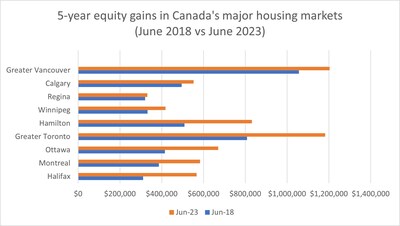Home ownership continues to be a top priority for Canadians coast to coast
TORONTO and KELOWNA, BC, July 19, 2023 /CNW/ — What began as a trickle of movement into housing markets late in the first quarter turned into a swell, as move-up buyers drove strong demand for residential properties across the country throughout the second quarter of the year, according to a report released today by RE/MAX Canada.
The RE/MAX Canada Move-Up Market Report examined nine of Canada’s biggest housing markets and found that buyers took advantage of the Bank of Canada’s (BoC) temporary pause in overnight rate hikes in the second quarter of the year, sparking a flurry of activity in the mid- to upper-price ranges. Tight inventory levels placed upward pressure on values, prompting double-digit price increases in five of the markets analyzed, between January and June of 2023, including Regina, Greater Toronto, Hamilton, Winnipeg and Montreal. Meanwhile, single-digit price upswings were noted in the four remaining markets – Greater Vancouver, Calgary, Ottawa and Halifax – as sellers held on to properties that fell short of peak price levels reported one year ago.
“January pretty much marked the trough for residential activity in markets across the country, as sales and prices reached new lows. When the BoC signalled its intent to hold on further interest rate hikes, the floodgates opened, sending buyers into the market from coast to coast,” says Christopher Alexander, President of RE/MAX Canada. “Inventory challenges re-emerged in most major centres as demand once again outpaced supply. Quality listings were quickly snapped up, many moving in multiple-offer situations, which served to draw more sellers into the market in April. By May, the market was moving full speed ahead until the BoC announced its decision to raise the overnight rate in June and again in July, taking the wind out of the proverbial sails of most markets, with some exceptions, namely Calgary, Regina and Montreal.”
Fear of further rate hikes continues to impact the market psyche, with many move-up buyers hoping to get into the market before rates climb again. RE/MAX brokers noted increased urgency in the market as buyers sought to obtain pre-approvals with guaranteed rate holds in place for a 120-day period, prior to both the BoC’s June and July announcements.
Equity gains also factored into Canadians’ decision to move up to larger homes or more preferable neighbourhoods, despite the pandemic-induced rise and fall of real estate value. This was especially true in central and eastern Canada. With trade-up activity traditionally occurring within four to seven years of the initial home purchase, RE/MAX examined pricing in June 2018 compared to June 2023 and found that almost every market reported a significant upswing in value over the five-year period, ranging from just over three per cent in Regina to more than 80 per cent in Halifax.
“While the threat of further interest rate hikes has given some pause to the market, particularly at entry-level price points, robust equity gains over the past five-year period provided the means and confidence to fuel solid buyer intentions in move-up markets across the country,” explains Alexander.
Necessity was the primary factor driving demand throughout the first half of 2023. Whether it was a growing family, the need for more space to accommodate new work-from-home arrangements and schedules, or a better school district, quality-of-life considerations were central to purchasing decisions. This proved true regardless of the move being made – whether downsizing or simplifying in more walkable neighbourhoods closer to the core, trading up or making lateral moves, urban or suburban.
“Inevitably, periods of contraction and short-term restraint ultimately give rise to increased pent-up demand,” says Elton Ash, Executive Vice President, RE/MAX Canada. “You can only hold back the impetus for so long. Real estate, after all, is driven largely by lifecycle events and broader factors such as population growth. While some will adjust their timing, most purchasers will eventually move forward, and we’ve seen that pattern emerge time and time again as move-up buyers nationwide re-ignite demand and competition for a limited number of listings.”
With July’s 0.25 basis point rate hike, the BoC’s key rate now sits at five per cent, and homebuyer activity is expected to slow heading through the summer months in most major Canadian housing markets. However, once it’s clear that the Bank of Canada is nearing the end of quantitative tightening and rates start to unwind, demand for housing will likely ramp up yet again. With uncertainty around financing out of the equation, the focus should remain squarely on supply again. In the move-up market and across the board, that will translate to renewed upward pressure on pricing.
“One simply cannot understate the serious repercussions the housing shortage will continue to have on Canadian real estate and affordability,” explains Alexander. “In the short term, while the BoC’s movements may clamp down on housing demand, especially at lower price points, we expect they will have unintended consequences, serving as a temporary dam causing pent-up demand to build and new home construction to contract. When the BoC decides to finally relax quantitative measures and the dam bursts, housing supply will fall even shorter amid record population growth.”
MARKET-BY-MARKET OVERVIEW
GREATER VANCOUVER
Home-buying activity in Greater Vancouver was strong out of the gate in 2023, with the Bank of Canada (BoC) decision to temporarily pause rate hikes prompting a burst of activity in late January. The market continued on an upward trajectory until the second week in May when demand started to moderate as thoughts turned to summer. The surprising rate hike in June stymied an already slowing market and pre-approved buyers with rate holds ramped up their search for housing. To date, just over 14,300 properties have sold, down just over 23 per cent from the 18,647 units sold during the same period in 2022. While benchmark prices have fallen short of year-ago levels, values have battled back to some extent over the past six months in Greater Vancouver, climbing eight per cent to $1,203,000 in June. Move-up buyers have been particularly active in 2023, given pent-up demand that continued to build while they were sidelined in late 2022. Vancouver’s suburbs have experienced the strongest demand, with detached homes in the $1.2 million to $1.5 million price range most sought-after. Space is still a major factor with suburban buyers, many of whom are looking to accommodate growing families. Strata attached properties in Langley’s Willoughby Heights and Walnut Grove have been a popular choice with young families, given the area’s proximity to Vancouver Proper. Maple Ridge has also experienced an upswing in buyers looking to trade up, although commute times are considerably longer. In Vancouver Proper, move-up buyers required around $1.5 million to trade-up to a larger townhome or half duplex this year. Some detached product is available in certain areas at the $1.5 million price point, but most listed for sale are being sold for land value only. Inventory remains one of the greatest challenges to buyers this year, with new listings falling short of the 10-year average, despite edging up year-over-year in June. Financing has been difficult but not insurmountable. Equity gains over the past five years have been a boon to move-up buyers, many who have had an easier time qualifying for a mortgage. Some move-up buyers, however, have moved farther afield to qualify, expanding their search to peripheral areas such as Chilliwack and Mission where housing values are more affordable. The Greater Vancouver housing market is expected to see a seasonal slowdown in the coming months, with the market is forecast to pick up again in the fall. Interest rates will play a critical role moving forward, dictating buyer behaviour on the mainland. If further rate hikes are implemented, the slowdown will be likely be extended. However, if rates are paused or decline, home-buying activity in Greater Vancouver is expected to rebound once again.
CALGARY
While housing sales remain more than 20 per cent off last year’s torrid pace, activity has been exceptionally robust in the first half of the year in Calgary. Inventory shortages across all housing types and price ranges have created a competitive marketplace, with one in every three homes now sold in a multiple offer situation. Lack of supply has impacted sales figures, with inventory down almost 30 per cent compared to last year. According to the Calgary Real Estate Board, more than 14,300 homes have sold year-to-date, down from 18,687 during the same period in 2022. Year-to-date average price now hovers at $539,668, close to two per cent ahead of the $529,826 reported one year ago, making Calgary one of the only markets in the country where average price now exceeds 2022 levels. Strong economic fundamentals and affordability are behind the push for housing in Calgary. Values are amongst the lowest in major Canadian centres. During the pandemic, the province saw a significant upswing in in-migration as affordable housing and job opportunities attracted buyers from other provinces, including British Columbia and Ontario. That trend has continued in 2023 as buyers from other provinces seek to realize homeownership. Move-up activity is strong in the city, with the greatest demand occurring between $500,000 and $700,000. Listings remain scarce as existing homeowners are reluctant to sell for fear of not being able to find a new home and/or get back into the market. Buyers have subsequently expanded their search perimeters to ensure that any two-storey home with a double-attached garage is considered, whether it’s in the north or south, east or west end of the city. Frustration is building with every lost bid. The latest of the Bank of Canada rate hikes, intended to quell activity, only served to drive more buyers into the market, many concerned that housing values will rise beyond their reach. Supply constraints are expected to be the greatest challenge facing buyers heading into the second half of the year when available listings typically decline. At the current rate, unit sales in Calgary are forecast to match or exceed year-ago levels, while average price pulls ahead.
REGINA
While economic concerns impacted home-buying activity in Regina early in the year, the market has steadily gained momentum in recent months. Year-to-date residential sales hover at 1,680, down from heady 2022 levels, but ahead of the 10-year average. Average prices fell just short of year-ago levels, currently sitting at about $312,000, but are up considerably from January to June. Move-up activity represents the largest cohort in Regina’s housing market, with the greatest activity noted between $200,000 and $350,000. Six hundred and thirty-eight properties have sold within those price points this year, representing approximately 38 per cent of overall sales. Detached homes are a perennial favourite given Regina’s affordable housing stock, with neighbourhoods in the east, west, north and south ends of the city experiencing strong activity. Inventory constraints, however, remain front and centre throughout Regina, with available listings down about 15 per cent from last year. A 2.8-month supply were available in June, according to the Saskatchewan Realtors Association. Well-priced homes at popular price points are seeing multiple offers as a result. The market appears to show no signs of slowing heading into the summer months. From an economic standpoint, Saskatchewan is expected to outperform all other provinces in GDP growth this year, supported by strong resource and agricultural sectors. This strength is expected to bolster consumer confidence and underpin steady move-up buyer activity in the residential real estate sector through year-end.
WINNIPEG
Steady upward momentum characterized home-buying activity in Winnipeg’s residential real estate market during the first half of the year, with buyers taking advantage of the Bank of Canada’s temporary pause in overnight rate hikes and lower housing values. Year-to-date average price declined by almost eight per cent to $405,301, down from $439,621 during the same period in 2022. A significant listing deficit has had an impact on sales this year, particularly at the $350,000 to $500,000 price point where demand is greatest. To date, just 3,347 properties have changed hands, down more than 20 per cent from year-ago levels. Supply is far more plentiful at the mid- to upper-end of the market, making it easier for move-up buyers to trade up to larger homes or different neighbourhoods in the $750,000 to $1 million price range. While necessity remains the primary driver for move-up activity in the city, with more space needed to accommodate growing families and, in some instances, multiple generations, equity gains have also come into consideration when deciding to upgrade. Homeowners who purchased in 2018, for instance, have realized gains exceeding 25 per cent over the five-year period, which has made financing less of a challenge due to the substantial downstroke. The sweet spot for most move-up buyers is between $700,000 and $800,000. Communities that resonate with move-up buyers include Waverley West, Bridgewater and Sage Creek in South Winnipeg. East St. Paul and West St. Paul on the outskirts of the city are also popular, offering up newer housing stock on larger lot sizes at a lower tax base. First-time buyers remain the most active segment of the Winnipeg market in large part due to the affordability factor, with the move-up cohort representing just five per cent of the overall market. While the Bank of Canada rate pause in January served to re-ignite home-buying activity in the city, the most recent hike has put a damper on the market. There has been an uptick in offers conditional on the sale of existing properties as a result. Some sellers are offering concessions on closing that include covering some of the buyers moving expenses; a portion of their land transfer tax; or $500 toward the buyer’s legal fees. Pre-approved buyers with rate holds – many of whom have yet to purchase – are expected to prop up housing sales over the softer summer months. Winnipeg’s housing market should pick-up steam in September, in line with the traditional fall upswing, with home-buying activity expected to remain stable for the remainder of the year.
HAMILTON
While lower housing values have brought buyers back into the Hamilton housing market, supply constraints at affordable price points have hampered sales activity. Just over 3,600 properties have changed hands in the first six months of 2023, down 24 per cent from the same period in 2022. Year-to-date average price has declined 14 per cent, despite an increase of close to 11 per cent in June compared to January of this year. First-time buyers have been exceptionally active in the market, driving sales of product priced under $800,000. The upward momentum in values caught many by surprise, sparking the leap into home ownership before prices moved beyond their grasp. Move-up buyers and those making lateral moves have been more strategic in their approach to home-buying this year, with most waiting for the right listing to come on-stream. Unique properties in sought-after neighbourhoods are moving quickly. The lack of product available for sale is having an impact on would-be move-up sellers, with many concerned that they may not be able to find a suitable home when they sell. Demand for move-up properties is greatest at the coveted $900,000 to $1.1 million price point, where just over 13 per cent of sales are occurring. Equity gains over the past five years have provided some incentive for buyers to trade up, while housing values have dropped from last year’s heady levels. Communities most popular with move-up buyers are those where walkability scores are high, including Ancaster, Burlington, Dundas, Stoney Creek, Waterdown, and Pelham. Some move-up buyers from the Hamilton area are looking farther along the QEW in areas such as Niagara-on-the-Lake where they can realize greater value for their dollar. Sales in Niagara Region overall have taken off in recent years, with the move-up market starting between $700,000 and $900,000. Economic expansion in Hamilton and the surrounding areas has led to tremendous job growth and opportunities in recent years. Affordability is a major factor, drawing homebuyers from the Greater Toronto Area and beyond. Given the cost of housing in Hamilton and the surrounding areas, demand for properties – condominium, townhouse, semi-detached or detached – is expected to remain steady throughout the summer months. The June interest rate hike shifted buyers into high gear, with many who have been pre-approved hoping to buy before their rate-holds expire. Showings, at present, are ahead of last year’s levels in Hamilton and Niagara, with most buyers prepared to pounce when they find their perfect home.
GREATER TORONTO AREA
Home-buying activity kicked into high gear with the advent of the traditional spring market as the BoC’s pause on overnight rate hikes brought greater stability to the Greater Toronto Area (GTA) housing market. Opportunities presented themselves across various price points in the second quarter of the year, encouraging those seeking to trade-up from a condo, townhome, semi or single-detached housing to explore their options as average price edged higher. Between January and June of 2023, the average price of a home in the Greater Toronto Area rose close to 14 per cent. Almost 39,000 properties changed hands in the first six months of the year, while year-to-date average price hovered at $1,144,512 in June, down about nine per cent from year-ago levels for the same period. The suburbs came alive early as move-up buyers sought to secure detached homes at more affordable price points, and “drive until you qualify” became the new mantra. Demand was particularly brisk for detached homes in the $1 million to $1.5 million price range, although inventory remained a consistent challenge. In the 416 area-code, potential buyers often found themselves frustrated by both the lack of and the quality of existing housing. Updated properties moved quickly in competitive situations, while tired, older homes lingered on the market. Financing was top of mind with consumers, especially given the Bank of Canada’s (BoC) move to raise the overnight rate by 0.25 per cent in June. Buyers who found primary financing arrangements challenging were unlikely to consider the secondary financing required for renovation projects. There has, however, been a greater appetite for shorter term and variable-rate mortgages in recent months, with many would-be buyers concerned that they will “get caught up” in the wrong part of the cycle. While the increase in overnight rates has taken some of the wind out of the sails of the housing market overall, most interested move-up buyers already have preapprovals in place. Many of those transactions will come to fruition over the next two to three months. Once stability returns to the housing market – when the threat of rising rates no longer exists, and inflation rates settle into a more normal pattern – home-buying activity will resume a healthier pace.
OTTAWA
The Bank of Canada (BoC) announcement to pause rate hikes in early January served to re-invigorate home-buying activity in the Ottawa market. Against a backdrop of lower housing values and less competition, buyers took to the streets early in the second quarter, taking advantage of more favourable market conditions, including five-year fixed rates at under five per cent. Move-up purchasers were at the forefront, driving demand for single-family homes and townhouses priced from $850,000 to $1 million. While more than 7,700 homes changed hands in the first six months of the year, volume is down almost 20 per cent from levels reported one year ago. Average price year-to-date hovers at $658,809, falling short of the $727,379 reported during the same period in 2022. Inventory levels have fallen – down 14 per cent from June of 2022– which has contributed to an upswing in average price so far this year. In the first six months, the overall average price has increased 7.5 per cent – with residential values in June pushing within four per cent of June 2022 levels. Equity gains factored into the decision to trade-up to larger homes or more preferable neighbourhoods for many this year, with average price up almost 60 per cent since 2018. There have also been a handful of buyers who purchased homes in 2021 choosing to upsize, selling their homes for what they paid in 2021 and applying the equity to the downpayment on their new home. Some buyers who purchased rural properties outside of the city early in the pandemic are now returning, deterred by longer commutes to downtown offices. Suburban Kanata/Stittsville, Barrhaven, and Orleans remain top destinations for move-up buyers this year, with an ample supply of larger homes on good-sized lots available for sale. Buyers interested in downtown Ottawa may find a townhouse or two available under the $1 million price point but most buyers will need to ante up to purchase a single-detached home. Market conditions are much tighter in the core, where supply constraints are contributing to an increase in competitive offers. While demand for homes in the first six months of the year has been relatively strong, the most recent BoC rate hike has created some uncertainty in the market moving forward. There are still a substantial number of pre-approved purchasers that have 120-day rate holds – which should serve to prop-up home-buying activity during the traditional summer slowdown – but moderation is expected to characterize the second half of the year, with performance comparable to the latter half of 2022.
MONTREAL
Move-up buyers, with concerns over further Bank of Canada (BoC) rate hikes, converged on Montreal’s residential housing market in the second quarter of 2023. According to the Quebec Professional Association of Real Estate Brokers (QPARB), year-to-date sales in the Montreal CMA still fall short of year-ago levels (20,477 vs. 26,600), but average price is climbing after bottoming out in January at just over $529,000. Prices have, in fact, edged up 10 per cent to $583,596 since January. Equity gains have played a substantial role in today’s market, strengthening the position of existing homeowners looking to upgrade. To illustrate, average price has increased 51 per cent between June 2018 ($385,860) and June 2023 ($583,596), meaning that homeowners have added almost $200,000 on average to their overall wealth in the five-year period through homeownership. Demand is greatest for freehold properties, ranging in price from $950,000 to $2 million at present. Turnkey properties are most sought-after, given the high cost of labour and construction materials in today’s inflationary marketplace. Proximity to the Metroline is also a priority, given the easy access to the downtown core and points east, west, north and south of the city. High walkability scores are also coveted. Sought-after communities include Le-Plateau-Mont-Royal, Verdun, Villeray, Rosemont and NDG, although some move-up buyers tend to trade up in the areas in which they currently reside. Condominiums have experienced a nominal uptick in demand from the upwardly mobile, but most move-up buyers are seeking freehold properties, either detached and semi-detached properties or duplexes that offer homeowners an opportunity to generate revenue while they live in one unit and rent the other. Downsizing or lateral moves are also occurring, albeit at a lesser pace. Financing is somewhat of a challenge, but most move-up buyers have a substantial downstroke against their new purchase. An ample supply of product is available across all price points. Well-priced and/or unique listings continue to see competition, but fewer properties are generating multiple offers well-over list price. Given solid demand and limited availability of housing stock, momentum in the Montreal is expected to continue into the second half of the year, despite the most recent rate hike.
HALIFAX
Pent-up demand and greater market stability drew buyers back into the Halifax housing market late in the first quarter and the trend continued throughout Q2. Despite inventory challenges and high mortgage rates, more than 2,500 homes changed hands in the six-month period, down 23 per cent from strong 2022 levels. Housing values have bounced back to some extent, rising almost nine per cent between January and June, with average price now hovering at $560,000, just $9,000 short of the $569,000 reported one year ago. Detached homes remain most popular with move-up buyers, with the vast majority seeking properties priced between $500,000 and $600,000. The move-up segment currently represents just over 20 per cent of market activity to date, compared to 18.4 per cent during the same period in 2022. Strong equity gains over the past five years have contributed to the upward movement, with values up approximately 80 per cent over 2018 levels. Multiple offers remain common under the $600,000 price point and in certain sought-after areas of the city such as the Halifax Peninsula, Sackville, and areas in Dartmouth. The Bank of Canada’s latest rate hike has had a nominal impact on demand thus far, but the full extent will be evident when buyer’s rate holds expire in early fall, and possible further rate increases. With the advent of the traditional summer market, sales are expected to taper somewhat, although the market should remain steady.
About the RE/MAX Network
As one of the leading global real estate franchisors, RE/MAX, LLC is a subsidiary of RE/MAX Holdings (NYSE: RMAX) with more than 140,000 agents in almost 9,000 offices with a presence in more than 110 countries and territories. RE/MAX Canada refers to RE/MAX of Western Canada (1998), LLC, RE/MAX Ontario–Atlantic Canada, Inc., and RE/MAX Promotions, Inc., each of which are affiliates of RE/MAX, LLC. Nobody in the world sells more real estate than RE/MAX, as measured by residential transaction sides.
RE/MAX was founded in 1973 by Dave and Gail Liniger, with an innovative, entrepreneurial culture affording its agents and franchisees the flexibility to operate their businesses with great independence. RE/MAX agents have lived, worked and served in their local communities for decades, raising millions of dollars every year for Children’s Miracle Network Hospitals® and other charities. To learn more about RE/MAX, to search home listings or find an agent in your community, please visit remax.ca. For the latest news from RE/MAX Canada, please visit blog.remax.ca.
Forward looking statements
This report includes “forward-looking statements” within the meaning of the “safe harbour” provisions of the United States Private Securities Litigation Reform Act of 1995. Forward-looking statements may be identified by the use of words such as “believe,” “intend,” “expect,” “estimate,” “plan,” “outlook,” “project,” and other similar words and expressions that predict or indicate future events or trends that are not statements of historical matters. These forward-looking statements include statements regarding housing market conditions and the Company’s results of operations, performance and growth. Forward-looking statements should not be read as guarantees of future performance or results. Forward-looking statements are based on information available at the time those statements are made and/or management’s good faith belief as of that time with respect to future events and are subject to risks and uncertainties that could cause actual performance or results to differ materially from those expressed in or suggested by the forward-looking statements. These risks and uncertainties include (1) the global COVID-19 pandemic, which has impacted the Company and continues to pose significant and widespread risks to the Company’s business, the Company’s ability to successfully close the anticipated reacquisition and to integrate the reacquired regions into its business, (3) changes in the real estate market or interest rates and availability of financing, (4) changes in business and economic activity in general, (5) the Company’s ability to attract and retain quality franchisees, (6) the Company’s franchisees’ ability to recruit and retain real estate agents and mortgage loan originators, (7) changes in laws and regulations, (8) the Company’s ability to enhance, market, and protect the RE/MAX and Motto Mortgage brands, (9) the Company’s ability to implement its technology initiatives, and (10) fluctuations in foreign currency exchange rates, and those risks and uncertainties described in the sections entitled “Risk Factors” and “Management’s Discussion and Analysis of Financial Condition and Results of Operations” in the most recent Annual Report on Form 10-K and Quarterly Reports on Form 10-Q filed with the Securities and Exchange Commission (“SEC”) and similar disclosures in subsequent periodic and current reports filed with the SEC, which are available on the investor relations page of the Company’s website at www.remax.com and on the SEC website at www.sec.gov. Readers are cautioned not to place undue reliance on forward-looking statements, which speak only as of the date on which they are made. Except as required by law, the Company does not intend, and undertakes no duty, to update this information to reflect future events or circumstances.
SOURCE RE/MAX Canada

Featured image: Megapixl © Fantasista


















